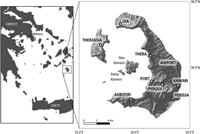Rapid emergency assessment of ash and gas hazard for future eruptions at Santorini Volcano, Greece
Jenkins F., S. Barsotti, T.K. Hincks, A. Neri, J.C. Phillips, R.S.J. Sparks, T. Sheldrake, G. Vougioukalakis.
Journal of Applied Volcanology, Volume 4, Issue 16, doi:10.1186/s13617-015-0033-y.
Abstract
Hazard assessments for long-dormant volcanoes, where information is rarely available, typically have to be made rapidly and in the face of considerable uncertainty and often poor information. A conditional (assuming an eruption), scenario-based probabilistic approach to such an assessment is presented here for Santorini volcano (Greece). The rapid assessment was developed and implemented in response to the 2011-2012 unrest crisis in order to inform emergency management and planning. This paper synthesises the results presented to the Greek National Committee and scientific community involved. Two plausible eruptions at Santorini were investigated, using multiple inputs and dispersal models, based on observations of historic eruptions and expert judgement. For ash hazard, a ‘most likely’ eruption scenario was developed, characterised by slow lava extrusion over periods of one to two years with weak but persistent explosions and ash venting up to 3 km. A second ‘largest considered’ sub-Plinian explosive scenario assumed a 12 km high column of 4-h duration. For gas hazard, constant fluxes of 200 and 800 tons/day SO2 were assumed for the duration of the eruption scenarios, noting that there is very little evidence to constrain SO2 flux from Santorini eruptions. Statistical models of likely wind conditions with height and season were developed from decadal reanalysis time series showing that consistent low-altitude winds were rarely maintained for more than a few days. Stochastic models of ash (TEPHRA2, VOL-CALPUFF) and gas (AERMOD) dispersal provided outputs in the form of probability maps and exceedance probability curves for key loading and concentration thresholds at important locations on the island. The results from the rapid assessments presented in this paper confirm that ash and gas hazard is likely to be of concern if an eruption of Santorini occurs. Higher hazard may be expected to the south and east of the volcano, notably at important tourist and transport hubs. Low hazard to the north and northwest suggests that these may be suitable locations for emergency response centres and emergency critical infrastructure. This approach may provide a blueprint for rapid ash and gas assessment for other long-dormant volcanoes and we provide suggestions for refining the methods used.


